
Fort tour reveals hard living, survival
DRY TORTUGAS, Fla.— It’s known as the ‘Rock of Gibraltar’ of the Western Hemisphere. Its walls are made of brick 8 feet thick and 45 feet tall. It is the largest water-based military fortress and once was the backbone of the United States Naval fleet.
Jeff Dennis is catching it all on his digital camcorder. It’s hot, there’s no natural source of fresh water for miles, and despite all this he doesn’t care.
This Indiana native sees this as an opportunity.
It is something he has only shared with his friends, but now it is becoming an experience he is capturing through his camera, and as he wipes the sweat off his brow, he gets a small taste of what is felt like to be on an isolated military fort during the nineteenth century.
Fort Jefferson is a former military base, which was used to guard and protect the Atlantic and Gulf Coast.
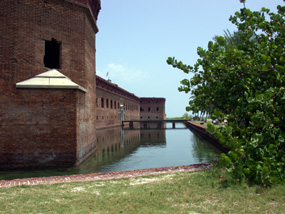 |
The moat and walls of the entrance at Fort Jefferson (Staff photo). |
Once a strategic military fortress, it now has become…a tourist attraction.
But this is not your average tourist attraction. The fort is located in the Dry Tortugas, on an island called Garden Key, one of seven islands located almost 70 miles west of Key Largo.
There are only two ways to get to the island: traveling by seaplane or by boat. Once on the island, tourists are taken on a voyage back in time to the 1840s when the fort was first created.
“Why in God’s name in the middle of an island would you have a moat wall? Why would you have a moat wall running through here?”
It’s a question Yankee Freedom guide, Mike Todd, presents to two dozen tourists outside the main entrance to Fort Jefferson. Even though it is isolated on an island, a moat surrounds the enter structure.
The massive walls of the fort are colored yellow, while the roof is covered in a dark red brick. This large structure, surrounded by water, oddly enough has a moat surrounding it.
Todd emphasizes the fort’s coastal defense system on his tour. He describes the island as a defense force for the American Navy only against enemy forces, but also against the harsh environment of the ocean.
Why would they build a moat in the middle of the ocean? It’s a good question. Just like why did the government of the United States build a military fort in the middle of the ocean? It’s all about defense. Against the enemies of America, and it was also designed to fight off the natural disasters of the Caribbean.
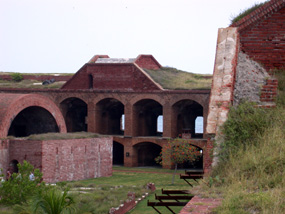 |
The magazine, where munitions were stored, sits in a corner of Fort Jefferson (Photo by Yu He). |
A moat for a fort in the middle of the ocean may seem odd, but remember, the engineers of the fort made it to defend against enemies, both human and nature.
It was created as a barrier just in case enemy forces came on the island. The moat also provides a barrier for the fort from large tidal waves, especially those found in hurricanes.
“It has been through many, many hurricanes. It still stands here. It did its job,” said Mike Todd proudly, as he stretches his arms to illustrate the strength of the over 16 million bricks used to construct the structure of Fort Jefferson. Todd is a tour guide for The Yankee Freedom II, a vessel which brings tourists to the Dry Tortugas National Park, and gives them an intimate view into the fort’s defenses and the human hardships of soldiers and prisoners who had lived on the island.
Yet military defense was not the only concern for the former inhabitants of Fort Jefferson.
United States soldiers had to defend themselves from the harsh environment of the Dry Tortugas. The island had no fresh water, no way to refrigerate or preserve food. A soldier had to rely on eating turtles, which were common in the Dry Tortugas.
Physical illnesses also plagued the inhabitants of Fort Wilderness. The inhabitants had two severe cases of yellow fever in 1868 and 1876. The final incident caused the inhabitants of the fort to abandon the island.
For anyone not familiar with the story of Fort Jefferson and the Dry Tortugas, the fortress was not made to be luxurious or accommodating to its inhabitants. Sources of food on the island were an obvious example of this. Todd gives his guests an example of what a soldier would expect to eat here.
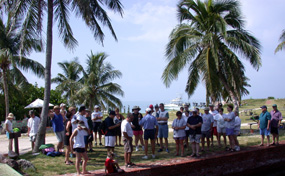 |
A Yankee Freedom tour group listens to Mike Todd at the fort entrance (Staff photo). |
“A soldier describes that bread! He describes it as a mixture of dough, mud, sticks and sand! They had two sources of protein: fish and beef. And they had bread. They had lots of health problems here…it was scurvy.”
Quality of food was limited for soldiers at Fort Jefferson.
The soldiers had scurvy because no fruits and vegetables could be grown on the island. The resolution to this problem was to bring supplies of lemon juice from Key West.
Food supplies were not the only problem for soldiers at Fort Jefferson. Visitors are given a unique insight of the lives of soldiers who lived there as much as 150 years ago. This park is not like Disney World, when you are parched of thirst, water fountains are conveniently located everywhere.
There is no fresh water on Fort Jefferson. And there is no bottled water for nearly 70 miles. It is called the ‘Dry Tortugas’ because there is no fresh water to be found on or near the islands.
“How do we get water? How do you keep these guys liquefied? They had a cistern system. It collected water under the fort in a sub-basement. In 1857, the engineers noticed something. The fort started to sink. It’s a lot of weight for a coral island,” Mike Todd exclaimed as he pointed out drainage ports located in ‘case mates,’ the name for rooms used to hold the fort’s cannons.
Despite the fact the plan to collect water for the fort was not a complete success, the park rangers at Fort Jefferson still use the water system just like the soldiers did over 100 years ago.
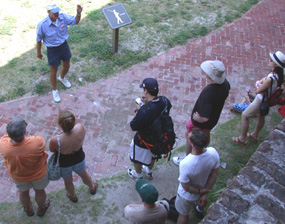 |
Yankee Freedom visitors listen to Mike Todd (Staff photo). |
Mike Ryan is the head interpretive ranger at Fort Jefferson. He has been a ranger at the Dry Tortugas for three years, and this is the sixth coastal fort he has been stationed at by the National Park Service.
He hopes tours offered by the Yankee Freedom II will give people a better understanding and appreciation on the history of Fort Jefferson.
“That is the excellent way of describing their challenge. If you can challenge your audience to think of this fort like they never thought about it before. When you make them think about it like modern 21st century American citizens, this fort has a lot in common with today’s homeland security,” said Mike Ryan.
This is how the tour of Fort Jefferson grabs the attention of its visitors, by relating its past to modern-day issues. The hardships of the soldiers living there and their mission to protect the United States. From the 1840s to the 1860s, the fort’s sole purpose was to be a refueling station for the Navy and protecting the shipping lanes from the Atlantic Ocean to the Gulf of Mexico.
For Ryan, it is important to explain the use of the fort for our country’s defense and how it signifies the way we use national security for the United States.
“When I have a chance to give tours myself, I try to connect modern visitors to why they built this big brick fort over one-hundred years ago. It may seem obsolete, but when they built this in 1846, this was the stealth bomber, the nuclear submarine of its day,” said Mike Ryan.
He hopes visitors to the island will appreciate its purpose when it was built, and its similarities to our concerns for our own security today.
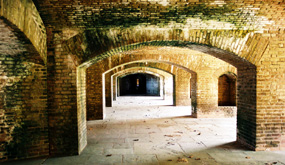 |
Fort Jefferson’s brick arches (Photo by Chris Rivera). |
The goal of this tour may have been to educate tourists about the coastal security of Fort Jefferson, but visitors were more amazed at how such a large fortress was built in the middle of the ocean.
Shawn and Wanda Whide, a couple from Florida, were amazed that the solitary Fort Jefferson was located in the middle of the ocean.
“What was amazing to me was the use of this land in the middle of nowhere. It is amazing what they were able to build out here,” said Shawn Whide, pointing to the deep blue waters, with nothing to see for miles. His wife, Wanda, was not as amazed as Shawn to see a large brick fortress, but was not expecting to find it in the middle of the ocean.
“We’ve seen things of these envisions back then. It was different, but I knew they had the capabilities to come up with these things. This was just a different setting,” said Wanda Whide.
For others, like Jeff Dennis from Indianapolis, going to the Dry Tortugas was an opportunity to see a place he only heard about from friends.
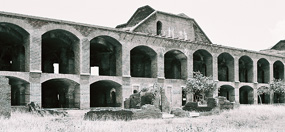 |
An unfinished portion of the fort (Photo by Chris Rivera). |
“I did not know why there was a fort, why it was there, and who built it. The tour answered a lot of my questions,” exclaimed Dennis as he gathered eight postcards at the gift shop on the deck of the Yankee Freedom II. He is buying the cards so he can send them to his friends and convince them to go back with him in two months.
He points to one of the postcards showing the landscape of the brick walls of Fort Jefferson and replies in excitement: “For the time it was built, that was genius! The undertaking was pretty incredible! I am amazed at what was built in the middle of the ocean. It’s pretty incredible stuff for an Indiana boy!”
A trip to The Dry Tortugas is not your average type of tourist attraction, considering many of the two dozen visitors in the tour group researched the history and location of the Dry Tortugas before taking the 2½ hour boat trip. The tour gives tourists a taste of the way of life at Fort Jefferson, and the hardships of the soldiers and prisoners who lived here, and demonstrates with great military might of brick fort.
 |
A cannon watches over the gulf (Photo by Chris Rivera). |
No battles were ever fought at the fort and no cannon was ever fired in battle. It adds to the mystique of the “Rock of Gibraltar” of the Western Hemisphere, built as a massive structure for war, never laying its eyes on enemy fire.
For tourists, it is an opportunity to once again understand the solitary reality of Fort Jefferson, an island fortress created in preparation of war and defense that never really saw its full potential. It now is a tourist attraction.
It now lies quietly in wait for the next group of tourists, somewhere … nowhere … in the middle of the Gulf of Mexico.
If You Go
- The Yankee Freedom ferry trip costs $119. Boarding is at 7:15 a.m. The Yankee Freedom leaves the Key West dock at 8 a.m. and arrives at the park around 10:30 a.m. The boat leaves the Dry Tortugas at 2:45 p.m. and returns to Key West around 5:30 p.m. The trip to the island will take 2 ½ hours.
- There are no public restrooms on the island until September 2003 and no fresh water. Travelers must use the restrooms on their ship and are advised to bring water. For current and updated information, check the park’s Web site at at http://www.nps.gov/drto/.
- A breakfast buffet is provided on the trip to the island and lunch is served at noon outside Fort Jefferson. This service varies from ship to ship.
- Besides the tour, the national park has a beach where visitors can snorkel, fish and stay overnight at the park camp grounds. Other activities include camping and fishing.
- Beginning June 1, 2003, there is a $5 entrance fee to enter Dry Tortugas National Park and Fort Jefferson.
- For more information, call the Dry Tortugas National Park at 305-242-7700 or visit the Web site.
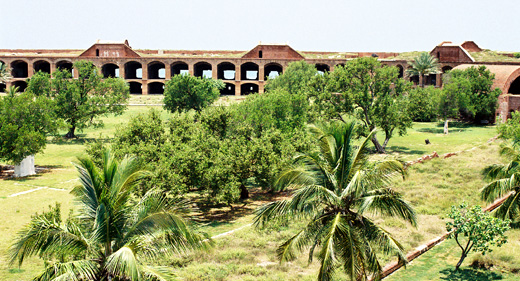 |
| The parade ground at Fort Jefferson (Photo by Chris Rivera ). |

Comments are Closed